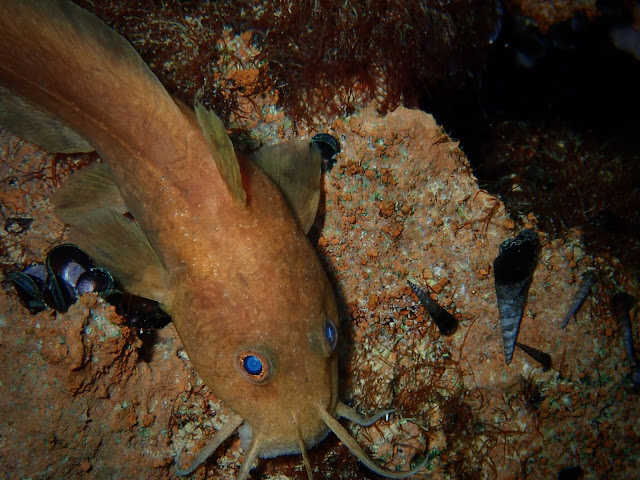Barracuda Lake - Coron Island, Philippines
Coron is one of the most popular tourist destinations in the Philippines. Usually, the streets are packed with foreign adventurers, eager to experience all that Coron has to offer, but these days, we’ve got the place to ourselves. So now that Coron has loosened movement restrictions, it’s time for us to see some surrounding sights. This time, we opted to visit one of the most renowned dive sites here, an underwater environment that feels like we’ve entered an entirely new world.
 |
| Getting geared up on the dock |
 |
| Then, carrying gear, we had to climb up and over the rocks to the lake |
 |
| Happy to be diving without a crowd! |
Salinity and Temperature
Tucked within the towering karst cliffs of Coron Island, lie the warm, cyan waters of Barracuda Lake. Formed by sunken limestone rock, this lake contains both fresh and saltwater, with a layer of brackish water nestled in between and heated by geothermal activity. The changes in both salinity and temperature cause the water to form three separate layers in which light refracts differently and impairs vision. The separation of varying water temperatures is called a thermocline, while the layering of water varying salinities refers to a halocline. At one point I could clearly see Mark beneath me, and then - boom - the water around me heated up and he suddenly became a pixelated blur of color, nearly unrecognizable! |
| The blur of thermocline |
The temperature continued to rise as I descended. At one point, I decided I didn’t particularly enjoy the sensation of sweat dripping down my forehead inside my mask. Slowly, I ascended back into the cooler water above. Mark continued to venture down to 30 meters and recorded a maximum water temperature of 38ºC (a sweltering 100.4ºF!) before finally entering the cooler saltwater layer at the bottom.
 |
| Still 39ºC even at 19 meters! |
 |
| Notice the dark reddish water behind Mark - tannins from dead leaves settle, creating a black abyss |
 |
| Limestone cliffs disappear in the depths |
Eerie Underwater Life
While Mark was experimenting with the water densities and temperatures, I decided to find out what kind of creatures could withstand this variable marine biome. The jagged limestone cliffs surrounding the lake continued all the way to the lake floor, creating plenty of nooks and crannies for brine shrimp to stake out their territory. As I approached, the crustaceans would charge out and pace about the rocky crevice, pincers raised in territorial warning. It is said that these centurion shrimp will gladly clean divers’ hands as they cling to the rocks, but I chose to simply observe from a safe distance this time. |
| Brine shrimp |
 |
| I got braver the second time we dove! |
 |
| Blue-eyed Dwarf Catfish |
 |
| Nearly transparent goby |
 |
| A rare, unidentified underwater species :) |
The Quarantined 'Cuda
Mark reappeared in the shallow waters and gave me an enthusiastic thumbs up as he grinned behind his regulator. He was enjoying the marvels of this mysterious place. While he was checking out the creatures I’d discovered already, I noticed something out in the distant water. A long shadow slowly came into view. A large barracuda was inching closer to us. Its stripes and teeth becoming more clearly defined as he approached. Some divers never get to see him, but I imagined after so many months with absolutely no tourists in his lake, he was quite surprised when we showed up! Some say the lake was named for an enormous barracuda skeleton that was found here, but others say it is named after this lone fish. I kept my eye on him and subconsciously covered up my silvery wedding band to avoid drawing him any closer.
I began to wonder how he’d found his way into this isolated lake. There must be an opening underwater through which he came, right? I’d heard of a cave down at 30 meters, was that opened to the sea? His solitary presence got my wheels turning and my thoughts waned poetic...
 |
| Photo courtesy of Divezone.net |
Barry the Lonesome ‘Cuda
They used to come in neon vests
Those tourists and their fins
Their hands attached to go pros,
Wearing cheezy, selfie grins.
They’d splash around and dive below
To feel the heat and see
The ripples in the thermocline
And changed salinity.
Gobies feed on the sunken floor.
The shrimp fend off their foes.
Blue-eyed catfish suck the slime,
All part of my underwater show.
This lake, you see, is named for me,
The “Barry”cuda Lake
Found in Coron, Philippines;
A trip tourists are sure to take.
But suddenly they've disappeared,
Those tourists and their grins.
I don’t know why they went away,
But I sure wish they’d come again.
A lonely fish, a brackish lake;
Sequestered from the sea.
I’m Barry the Lonesome ‘Cuda,
Now it’s just the shrimp and me.






Comments
Post a Comment